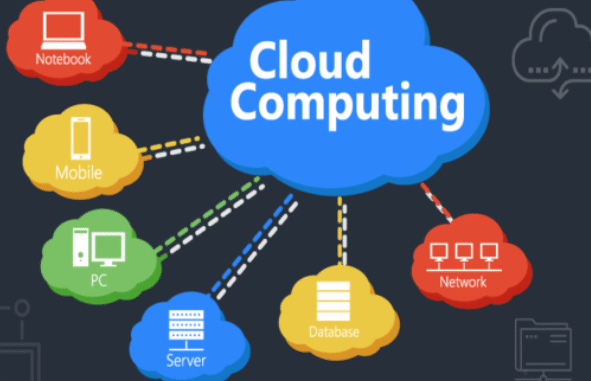
Introduction
In today’s digital world, data is the lifeblood of businesses. Every app, website, and online service relies on vast amounts of information that must be stored, processed, and accessed securely. That’s where cloud computing comes in. It has completely transformed how individuals and organizations manage their data, making technology more flexible, scalable, and cost-effective than ever before.
This article explains what cloud computing is, its main types, benefits, and the exciting trends shaping its future.
1. What Is Cloud Computing?
Cloud computing is the delivery of computing services—like storage, servers, databases, networking, and software—over the internet, often called “the cloud.” Instead of owning physical servers or hardware, users can rent access from cloud providers such as Amazon Web Services (AWS), Microsoft Azure, and Google Cloud Platform (GCP).
In simple terms, cloud computing lets you access technology resources on-demand, from anywhere, without the need for expensive infrastructure.
2. The Main Types of Cloud Computing
Cloud computing can be divided into three major service models:
a. Infrastructure as a Service (IaaS)
IaaS provides virtualized computing resources like storage, servers, and networking. Businesses can build and manage their own applications on top of these virtual machines.
Examples: Amazon EC2, Google Compute Engine, Microsoft Azure.
b. Platform as a Service (PaaS)
PaaS offers a ready-to-use environment for developers to build, test, and deploy applications without managing the underlying infrastructure.
Examples: Google App Engine, Heroku, AWS Elastic Beanstalk.
c. Software as a Service (SaaS)
SaaS delivers software applications over the internet. Instead of installing software on devices, users access it through a web browser.
Examples: Gmail, Zoom, Dropbox, Salesforce.
3. Deployment Models: Public, Private, and Hybrid Clouds
There are also three main deployment models for cloud computing:
- Public Cloud: Shared infrastructure managed by third-party providers (e.g., AWS, Google Cloud).
- Private Cloud: Infrastructure dedicated to a single organization, often used by large enterprises needing extra security.
- Hybrid Cloud: Combines public and private clouds, allowing data and applications to move between them seamlessly.
4. Key Benefits of Cloud Computing
a. Cost Efficiency
With cloud services, businesses only pay for what they use. There’s no need to buy or maintain costly servers—saving huge amounts on hardware and maintenance.
b. Scalability
Cloud resources can scale up or down instantly depending on demand. For example, e-commerce websites can handle traffic spikes during holiday sales without crashing.
c. Accessibility and Collaboration
Cloud computing enables employees to work from anywhere and collaborate in real-time. Tools like Google Workspace and Microsoft 365 make teamwork seamless across continents.
d. Security and Backup
Leading cloud providers use advanced encryption and regular backups to protect data from loss or cyberattacks. Many also comply with strict data protection regulations like GDPR.
e. Environmental Sustainability
By sharing resources more efficiently, cloud computing reduces energy consumption and helps companies lower their carbon footprint.
5. Cloud Computing in Everyday Life
Cloud technology is part of our daily routines—whether we realize it or not. When you stream music on Spotify, back up photos to Google Drive, or use online email, you’re using the cloud. Businesses also rely on it for CRM systems, analytics, AI applications, and more.
6. Challenges of Cloud Computing
Despite its advantages, cloud computing faces challenges such as:
- Data Privacy: Storing sensitive information offsite raises security concerns.
- Downtime: Even top cloud providers occasionally experience outages.
- Vendor Lock-in: Moving data between different cloud services can be difficult and costly.
To address these, companies are adopting multi-cloud strategies—using several providers to avoid dependence on one platform.
7. The Future of Cloud Computing
The next decade of cloud technology looks even more exciting. Key trends include:
- Edge Computing: Moving data processing closer to where it’s generated, reducing latency for applications like autonomous vehicles.
- AI Integration: Cloud platforms increasingly use artificial intelligence to automate scaling, security, and analytics.
- Serverless Computing: Developers can run code without managing servers at all—reducing costs and complexity.
- Quantum Cloud Services: Soon, quantum computing capabilities will be available via the cloud, offering massive computing power to everyone.
As more organizations go digital, cloud computing will remain the foundation of modern innovation.
Conclusion
Cloud computing has reshaped the digital landscape, offering speed, flexibility, and security to businesses of all sizes. Its ability to scale effortlessly and support global collaboration makes it one of the most important technologies of our time. As we move toward an increasingly connected world, the cloud will continue to power innovation, efficiency, and growth across every industry.

Leave a Reply